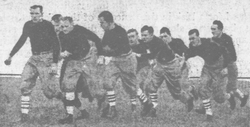Lorin F. Deland
Lorin Fuller Deland (1855-1917) was head coach of the Harvard Crimson football team for three games in 1895, after having been a football "adviser" to the team beginning in 1892. He invented the “flying wedge” formation, which was unveiled in a 6-0 loss to Yale in the championship game of 1892. Later, Deland collaborated with former Yale Bulldogs football coach Walter Camp on the seminal book titled Football, published in 1896.
Background
Deland was an independently wealthy Bostonian who dabbled in a number of interests. At various times in his life, he was a publisher, owned an advertising agency, was a military historian, author, reporter, actor, and chess master. He even wrote the words to a popular 1900 song entitled “Dinah”. Deland appeared in many local theatre productions, and the income from his advertising agency was used to support several local charities. On May 12, 1880, he married Margaret Deland, who later gained fame as a novelist, short story writer, and poet. Deland had inherited his father's publishing company, which he sold in 1886 to go into advertising, as well as opening a greeting card business. Margaret’s writing career began by authoring verses for her husband's greeting cards.
Football and the Flying Wedge
Deland never played football or even attended a football game until 1890, when he was in his mid-thirties. Within two years he was helping to coach Harvard and was recognized as a football genius. Deland analyzed the American sport as if it were a battlefield and devised plays based on his study of Napoleon Bonaparte and military tactics. Deland’s biggest innovation was the latest and greatest of the mass-momentum plays, the fabled “flying wedge.” Deland theorized that the key to the sport was to catapult all one's strength at the enemy's weakest point. Deland worked with the Harvard team on a voluntary basis to perfect the flying wedge, a violent assault by several men on a single opponent.

Walter Camp’s confidante Theodore S. Woolsey reported to Camp in July 1892 that Lorin Deland was adapting “military strategy to football” and “testing the practicability of these new plays.” Yet, Woolsey questioned whether Harvard players could carry them out. He noted: “To work them out at all would require a standard of team play which Harvard is not usually up to.”
Harvard’s 1892 team had an undefeated 10-0 record heading into its end-of-year showdown with the Yale Bulldogs, coached by football pioneer Walter Camp. Though the team had been working on the flying wedge formation since the pre-season, Deland was saving its unveiling for the Yale game. Against Yale in 1892, Harvard opened the second half with a kickoff, but in those days it was legal to tap the ball and then put it in play by running with it or handing or pitching to a teammate. Using this strategy, Harvard implemented their devastating new play. According to football historian Parke H. Davis:
Deland divided Harvard's players into two groups of five men each at opposite sidelines. Before the ball was even in play team captain Bernie Trafford signaled the two groups. Each unit sprang forward, at first striding in unison, then sprinting obliquely toward the center of the field. Simultaneously, spectators leapt to their feet gasping. Restricted by the rules, Yale's front line nervously held its position. After amassing twenty yards at full velocity, the "flyers" fused at mid-field, forming a massive human arrow. Just then, Trafford pitched the ball back to his speedy halfback, Charlie Brewer. At that moment, one group of players executed a quarter turn, focusing the entire wedge toward Yale's right flank. Now both sides of the flying wedge pierced ahead at breakneck speed, attacking Yale's front line with great momentum. Brewer scampered behind the punishing wall, while Yale's brave defenders threw themselves into its dreadful path.
Despite the effectiveness of the flying wedge, Yale won the game 6-0.
Deland continued to act as an unpaid coach and adviser to the Harvard team until he was appointed head coach in 1895, after the Crimson lost 12-4 to Princeton in the eighth game of the season. Deland led the team to a 4-0 win over the Michigan Wolverines, a 0-0 tie with the Boston Athletic Association, and a 17-14 loss to the Penn Quakers. Though he left coaching after the 1895 season, he maintained an interest in football throughout his life. Deland and Yale coach Walter Camp collaborated in 1896 to write their comprehensive study of the sport, titled simply Football. Camp probably did more than anyone else to popularize the game and to shape the rules as they now stand including cutting the number of players to 11 (from 15), instituting the quarterback position, creating a scrimmage to institute play (rather than a "scrum") and designing the "gridiron" pattern of the field. The diagrammed plays in the book were drawn by Deland’s wife.
Publications
- Football, by Walter Camp and Lorin F. Deland. Published by Houghton Mifflin, Boston, 1896
- Imagination in Business, Published by Harper & Brothers, 1909
- At the Sign of the Dollar and Other Essays, Published by Harper & Brothers, New York, 1917
- The Musical Record: A Journal of Music-Art-Literature, Number 415, August 1896 (edited by Deland), published by Oliver Ditson Co., Boston, 1896
- The Lawrence Strike: A Study, The Atlantic Monthly, May 1912
- Football at Harvard and at Yale, The Atlantic Monthly, November 1910, pp. 700-713
References
- Theodore S. Woolsy, York Harbor, Maine letter to Walter Camp, New Haven, Connecticut, ca. 17 July 1892, Theodore S. Woolsey Folder, Walter Camp Papers, Yale University Archives
- Football: The American Intercollegiate Game, by Parke H. Davis, published by Charles Scribner's Sons, New York, 1911
- The H Book of Harvard Athletics, 1852-1922 by John A. Blanchard, published by The Harvard Varsity Club, Cambridge, 1923